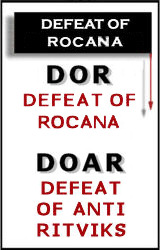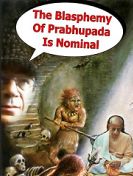 Prabhupada, Conversatin with Mike Robinson of London Broadcasting Company:.. In a living body the soul is there, and in a dead body the soul is not there. As soon as the soul leaves the body, the body has no value. It is useless. This is very simple to understand, but even the biggest so-called scientists and philosophers are too dullheaded to understand it. Modern society is in a very abominable condition. There is no man with a real brain…Full Conversation
Prabhupada, Conversatin with Mike Robinson of London Broadcasting Company:.. In a living body the soul is there, and in a dead body the soul is not there. As soon as the soul leaves the body, the body has no value. It is useless. This is very simple to understand, but even the biggest so-called scientists and philosophers are too dullheaded to understand it. Modern society is in a very abominable condition. There is no man with a real brain…Full Conversation
Basics
New York Times: Peering Over the Fortress That Is the Mighty Cell
By NATALIE ANGIER
Published: May 31, 2010
When J. Craig Venter announced at a news conference the other day that he and his co-workers had created the first “synthetic cell,” he displayed the savvy graciousness of an actor accepting an Academy Award.
Dr. Venter, the renowned genome wrassler and president of the J. Craig Venter Institute, praised his two dozen team members and described the long years of struggle that preceded their moment of triumph. He called out important figures in the audience: his editor, his literary agent, the celebrity diet doctor Dean Ornish. And he acknowledged that none of his group’s work would have been possible without a lot of help from the parents — Mother Nature and Father Time.
After all, that stalwart pair was responsible for designing and gradually refining the real cells that brought the Venter team’s synthetic constructs to life. There is, as yet, no escaping the cell. Every past and present lodger on the twisted bristlecone tree of life is built of cells, every cell is a microcosm of life, and neither the Venter team nor anybody else has come close to recreating the cell from scratch. If anything, the new report underscores how dependent biologists remain on its encapsulated power.
As reported in the journal Science on May 20 to international attention, the Venter team managed to recreate with bottled chemicals the entire genetic code of one species of bacterium and transplant that manufactured genome into the housing of a closely related species of bacterium. Once installed, the synthetic DNA began operating like the real thing, prompting its cellular surroundings to produce a protein work force appropriate to its needs rather than that of the original bacterial host, to copy the synthetic DNA, and to do what all bacteria love to do, which is divide over and over again.
The researchers now have many descendants of that founding microbial construct stored in a freezer, all of them nearly indistinguishable from what you’d get if you cultivated the “donor” bacterium naturally. Only on looking carefully at the genetic sequence in each cell would you find the researchers’ distinguishing “watermarks,” brief chemical messages inserted into the otherwise plagiarized string of one million-plus letters of bacterial DNA.
The harmless nucleic interjections include encrypted versions of the researchers’ names and three apt if self-conscious quotations: “See things not as they are, but as they might be,” from a biography of the physicist Robert Oppenheimer; “What I cannot build, I cannot understand,” by Richard Feynman; and “To live, to err, to fall, to triumph, and to recreate life out of life,” by James Joyce, which, when taken together with the fact that the physicist Murray Gell-Mann named the fundamental particles of the atomic nucleus “quarks” after a line in Joyce’s “Finnegans Wake,” suggests that scientists are at least as fond of the nougaty Irish novelist as is the average English major.
Other researchers were impressed by the work but were quick to keep the feat on the ground. “There’s no doubt in my mind that this is a major achievement,” said Steen Rasmussen, a professor of physics at the University of Southern Denmark who works in the field of synthetic biology. “But is it artificial life? Of course not.”
Bonnie L. Bassler, a microbiologist at Princeton, said, “They started with a known genome, a set of genes that nature had given us, and they had to put their genome into a live cell with all the complex goo and ingredients to make the thing go.”
Dr. Venter freely admitted his indebtedness to precedence. His team, he said, was “taking advantage of three and a half billion years of evolution.” Throughout those preposterous eons, nature has had a chance to perfect the splendid entity of all earthly animation that is the living cell. And though researchers have made some tentative progress in their efforts to synthesize other essential elements of the cell apart from the genome, don’t expect even a cheap knockoff anytime soon. “I am always awed by nature,” Dr. Bassler said, “and how it manages to work so well.”
There is a reason why life is built of cells, and why most cells are too small to see without a microscope. It’s easy in a small space to keep critical components squeezed together and close at hand, the better for the right enzymes to encounter the right substrates in a timely fashion and a million tiny bonfires to burn. “Cells are not like an aquarium where a fish swims by now and again,” said Dr. Bassler. “They’re jam-packed inside. They’re teeming with stuff. They’re like a house filled with necessary clutter, or New York City, or a Thanksgiving table loaded with so many dishes you don’t know where you might put another plate.”
Much of the cell’s interior is taken up by the cytoplasm, which, as several biologists have gleefully observed, pretty much has the texture of snot. The appearance of random ooze, however, is deceptive. “There’s a beautiful architecture” to the cytoplasm, Dr. Bassler said. “Everything is in the right place and bumping around, and the membrane holds them together so they can’t get away from each other.”
When the Venter team inserted the synthetic version of the Mycoplasma mycoides genome into the cellular housing of the Mycoplasma capricolum bacterium, the newcomer took full advantage of the resident cytoplasmic wares. It used the thousands of little biodevices called ribosomes to stitch together amino acids into new proteins. It relied on complex molecular assemblages to maintain its DNA in working order and to duplicate that DNA when it was time to divide. It thanked its lucky base pairs that a greasy lipid cell membrane and stiffer bacterial wall not only kept the inside appropriately, bioactively dense, but also kept the outside appropriately out, for an exposed cytoplasm would soon be scavenged for parts, most likely by a neighboring microbe.
Considered together, the modern cell is dauntingly complex, which is why most researchers in the youngish field of synthetic biology address only one or two pieces of it at a time. Last year, George Church of Harvard Medical School and his colleagues reported that they had created an artificial ribosome. James J. Collins, the co-director of the Center for Biodynamics at Boston University, is working on a synthetic DNA toggle switch, to flip genes on and off at will.
In Denmark, Dr. Rasmussen is seeking to design the most stripped-down minimalist suggestion of a functioning cell. As he sees it, there are three basic capacities that a living cell must possess. It must have a means of channeling free energy in the environment to meet its demands: that is, it must have some form of metabolism. It must have an enclosure: a cell membrane. And it must have the informational wherewithal to reproduce itself: a genome. Dr. Rasmussen and his co-workers have devised reasonable if crude facsimiles of the three cellular non-negotiables, and they’ve managed to merge two of them together in any given experiment — and in one case even all three of them. The goal of contriving a self-replicating and autonomously metabolizing protocell, however, continues to elude them. “We have the instruments,” he said, “but it doesn’t sound like an orchestra yet.”
Just pick up your baton, hum a few bars, and give it three billion years.







Speak Your Mind